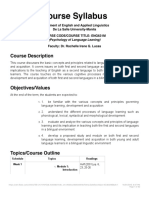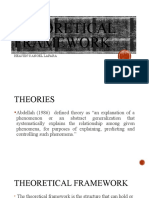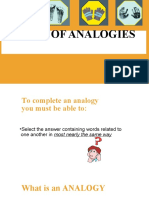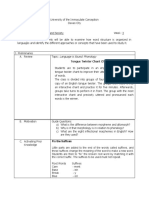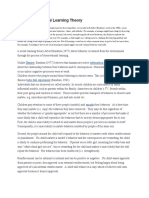CH 7 Lcs-Lp-Amerol-Ramos
Uploaded by
Heaven's Angel LaparaCH 7 Lcs-Lp-Amerol-Ramos
Uploaded by
Heaven's Angel LaparaFor the purpose of uniformity,
please use Tahoma, 11.
University of the Immaculate Conception
Davao City
LEARNING PLAN
Course: Acquiring Languages: Life with First Languages, Second Languages, and more
Week: 5
Learning Outcome: In this chapter the students will be able to identify on what is a first
language and a second language means.
I. Preliminaries
A. Review Topic: The Development and Evolution of
Language
Below are the examples of acoustic channel, optical
channel, tactile channel, and olfactory channel. The
class must fill in the blank with the given choices:
1. In the exhibit, the _____ experience involves
the release of numerous scents into a
controlled environment. (olfactory)
2. The violin is a ______ instrument that emits
sounds when the strings are arranged by
skilled fingers. (tactile)
3. It is the most common and effective channel
of human communication _____. (acoustic
channel)
4. Writings, gestures, and pictorial signs is the
use of ____ relating to vison. (optical
channel)
5. The _____ is especially important among
social insects, which do much of their
communicating by means of odors in the
species-specific substances known as
pheromones they secret. (olfactory
channel)
B. Motivation Guide Questions:
UIC (Education Subject Code and Title: Date: (August 15-18,
Page 1 of 4
Program) (English 10: Introduction to Linguistics) 2016)
For the purpose of uniformity,
please use Tahoma, 11.
a. What is the first steps of the language
acquisition in childhood?
b. What is the difference between the
first language and second language?
c. What is a sociocultural theory?
C. Activating Prior Knowledge To answer the following questions, students will be
watching a short presentation on how a child acquire
language.
https://www.youtube.com/watch?v=_1DlxmLiN3s
II. Lesson Development
A. Presentation of Concepts The Students can:
At the end of the course the students can:
A. Able to identify the difference between the
first language acquisition and second
language acquisition.
B. Students will learn on what are the first steps
of language acquisition in childhood
C. Students can also know the theories of
language acquisition
D. The students can also be able to understand
the use of language and the brain
E. The students will understand the differences
of the code-switching, code-mixing, and
diglossia.
D. Activities
A. The class will be divided into 3 groups. The
students must perform the different use of
code-switching, code-mixing, and diglossia.
B. The class will be divided into 3 groups, and
each groups must complete the puzzle that
they’re given the first one to finish will be the
winner.
C. One student must go to the front and
him/her will be given a word that cannot be
seen by other students. He/she will draw (on
the blackboard) a picture expressing the
UIC (Education Subject Code and Title: Date: (August 15-18,
Page 2 of 4
Program) (English 10: Introduction to Linguistics) 2016)
For the purpose of uniformity,
please use Tahoma, 11.
concept of the word. And the rest of the
class have to guess the word.
If the player keeping score, the one who
drew the picture gets the point if the class
can guess the word.
A. Broadening of
Concepts
I. What is the connection between the
first language acquisition in children
and second language acquisition in
adults?
II. How do individuals acquire and
develop language?
B. Four-Pronged 1. Ignacian Core Values/Related Values:
Integration Excellence: Diversity
2. Social Orientation:
Why is there a need to study about how a
child acquire its first language and second
language?
Lessons Across Discipline:
“One language sets you in a corridor for life.
Two languages open every door along the
way.”
- Frank Smith
a) What does this quote imply?
b) Based on your own idea, what is Frank
Smith trying to tell us?
4. Faith/Biblical Reflection:
"Start children off on the way they should
go, and even when they are old they will
not turn from it.”
-Proverbs 22:6 (NIV)
a) What does this bible text mean in connect to
UIC (Education Subject Code and Title: Date: (August 15-18,
Page 3 of 4
Program) (English 10: Introduction to Linguistics) 2016)
For the purpose of uniformity,
please use Tahoma, 11.
our topic today?
III. Summary and Synthesis
Reflection Paper
a) What have you learned in the topic today?
b) Why is it important to study about the theories of acquiring languages?
c) Why do you think learning a second language is difficult?
IV. Assessment:
The class will be divided into 3 groups. And each group must perform the stages of
speech development that characterized the language acquisition in children.
V. Purposive Assignment
A. In a ½ crosswise, give at least two examples each about the code-mixing, code-
switching, and diglossia.
Prepared by:
Hanifa D. Amerol
Julieanne B. Ramos
BSED-1B Major in English
04/09/2019
Checked by:
UIC (Education Subject Code and Title: Date: (August 15-18,
Page 4 of 4
Program) (English 10: Introduction to Linguistics) 2016)
You might also like
- Best Practices in Adolescent Literacy Instruction PDF100% (4)Best Practices in Adolescent Literacy Instruction PDF418 pages
- Ovando, C.J. Et. Al. Bilingual & ESL Classrooms-Teaching in Multicultural ContextsNo ratings yetOvando, C.J. Et. Al. Bilingual & ESL Classrooms-Teaching in Multicultural Contexts6 pages
- (Michigan Teacher Training) Steven Brown, Salvatore Attardo - Understanding Language Structure, Interaction, And Variation_ an Introduction to Applied Linguistics and Sociolinguistics for NonspecialisNo ratings yet(Michigan Teacher Training) Steven Brown, Salvatore Attardo - Understanding Language Structure, Interaction, And Variation_ an Introduction to Applied Linguistics and Sociolinguistics for Nonspecialis235 pages
- Educational System in The Philippines and in SingaporeNo ratings yetEducational System in The Philippines and in Singapore42 pages
- Practicing COVID-19 Preventive Measures in The Workplace - Certificate of CompletionNo ratings yetPracticing COVID-19 Preventive Measures in The Workplace - Certificate of Completion1 page
- SYLLABUS - THEORIES OF LANGUAGE ACQUISITIONNo ratings yetSYLLABUS - THEORIES OF LANGUAGE ACQUISITION6 pages
- Lesson 1. Concepts of Language. Directions in Linguistics. Epistemology of Language Teaching. 1.1. CNo ratings yetLesson 1. Concepts of Language. Directions in Linguistics. Epistemology of Language Teaching. 1.1. C7 pages
- Lesson 4 With Review Powerpoint LANGUAGE ACQUISITIONNo ratings yetLesson 4 With Review Powerpoint LANGUAGE ACQUISITION140 pages
- Linguistics Lecture Day 1-3.pptx Version 1No ratings yetLinguistics Lecture Day 1-3.pptx Version 1101 pages
- Language Acquisition Autobiography Jacob LooneyNo ratings yetLanguage Acquisition Autobiography Jacob Looney6 pages
- Lesson Plan - Language Acquitision Week 1No ratings yetLesson Plan - Language Acquitision Week 112 pages
- Final - Rasmika - Introduction To Linguistic GrupNo ratings yetFinal - Rasmika - Introduction To Linguistic Grup3 pages
- Danilo Paiba First and Second Language AcquisitionNo ratings yetDanilo Paiba First and Second Language Acquisition5 pages
- The Role of Linguistics in Second Language Classrooms: Liang-Chen LinNo ratings yetThe Role of Linguistics in Second Language Classrooms: Liang-Chen Lin6 pages
- Answer-for-Problems-in-Language-Instruction - FloresNo ratings yetAnswer-for-Problems-in-Language-Instruction - Flores12 pages
- Theme 1 Introduction To Language AcquisitionNo ratings yetTheme 1 Introduction To Language Acquisition16 pages
- Google Meet Schoology Quizzes Slide PresentationNo ratings yetGoogle Meet Schoology Quizzes Slide Presentation4 pages
- Lesson 2 Language Acquisition-240111 - 090653No ratings yetLesson 2 Language Acquisition-240111 - 09065325 pages
- Module 1 Topic 1 The Nature of Language Final 1No ratings yetModule 1 Topic 1 The Nature of Language Final 19 pages
- 0232 2101intro To Linguistics Course Outline Batch 51No ratings yet0232 2101intro To Linguistics Course Outline Batch 515 pages
- Course Syllabus: College: Education Program: Bsed - 2 YrNo ratings yetCourse Syllabus: College: Education Program: Bsed - 2 Yr9 pages
- Definition of Second Language Acquisition and Learning0% (1)Definition of Second Language Acquisition and Learning48 pages
- (Template) MAJOR 1 1st Study Guide and Learning TaskNo ratings yet(Template) MAJOR 1 1st Study Guide and Learning Task7 pages
- Course-Outline Principles and Theories of Language Acquisition and LearningNo ratings yetCourse-Outline Principles and Theories of Language Acquisition and Learning4 pages
- Language Acquisition Autobiography Engl 420 VHNo ratings yetLanguage Acquisition Autobiography Engl 420 VH8 pages
- Listen To A Lecture and Define The Following Statements.: Activity 1. Listening Comprehension What Is A Language?No ratings yetListen To A Lecture and Define The Following Statements.: Activity 1. Listening Comprehension What Is A Language?6 pages
- Where can buy (eBook PDF) Born to Talk: An Introduction to Speech and Language Development 7th Edition ebook with cheap price86% (7)Where can buy (eBook PDF) Born to Talk: An Introduction to Speech and Language Development 7th Edition ebook with cheap price46 pages
- Visual and Multimedia Elements' Effect On Text100% (1)Visual and Multimedia Elements' Effect On Text16 pages
- Topic 1: Introduction To Grammar: Week 1No ratings yetTopic 1: Introduction To Grammar: Week 157 pages
- Figure 1. Baganga, Davao Oriental Figure 2. Lambajon, Baganga, DVO OR100% (1)Figure 1. Baganga, Davao Oriental Figure 2. Lambajon, Baganga, DVO OR4 pages
- Theoretical Framework: Heaven'S Angel LaparaNo ratings yetTheoretical Framework: Heaven'S Angel Lapara11 pages
- Cultivating The Leader Within, Responding Inclusively To The New Educational MilieuNo ratings yetCultivating The Leader Within, Responding Inclusively To The New Educational Milieu1 page
- Teaching Grammar in Context and Isolation & Ensuring The Assessment Is PreciseNo ratings yetTeaching Grammar in Context and Isolation & Ensuring The Assessment Is Precise14 pages
- Group 6: Aytong JR., Nicolas Lapara, Heaven'S Angel Miranday, Grace Gin Peñaflor, Myra Salutillo, Marielle KayeNo ratings yetGroup 6: Aytong JR., Nicolas Lapara, Heaven'S Angel Miranday, Grace Gin Peñaflor, Myra Salutillo, Marielle Kaye14 pages
- Difference Among Assessment, Evaluation, and Testing: Members: Amerol, Jumawan, Luyao, Rico0% (1)Difference Among Assessment, Evaluation, and Testing: Members: Amerol, Jumawan, Luyao, Rico10 pages
- Yerror Analysis On The Essays of The Education StudentsNo ratings yetYerror Analysis On The Essays of The Education Students21 pages
- Integrating Hots Using Spider Web Multiplication in Basic Multiplication FactsNo ratings yetIntegrating Hots Using Spider Web Multiplication in Basic Multiplication Facts12 pages
- A Comparison of Online-Face-To-Face Students' and Instructor's PDFNo ratings yetA Comparison of Online-Face-To-Face Students' and Instructor's PDF5 pages
- Filipino Phil Iri Individual Grade 6 Masikap 2024 2025No ratings yetFilipino Phil Iri Individual Grade 6 Masikap 2024 20252 pages
- Reaction Paper Regarding The Proposed k12 Education88% (24)Reaction Paper Regarding The Proposed k12 Education1 page
- Central Board of Secondary Education Secondary School Examination (Class-X) 2015No ratings yetCentral Board of Secondary Education Secondary School Examination (Class-X) 20151 page
- Kalaisan National High School Kalaisan Kidapawan CityNo ratings yetKalaisan National High School Kalaisan Kidapawan City20 pages




















